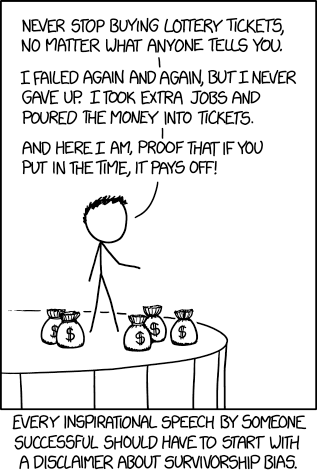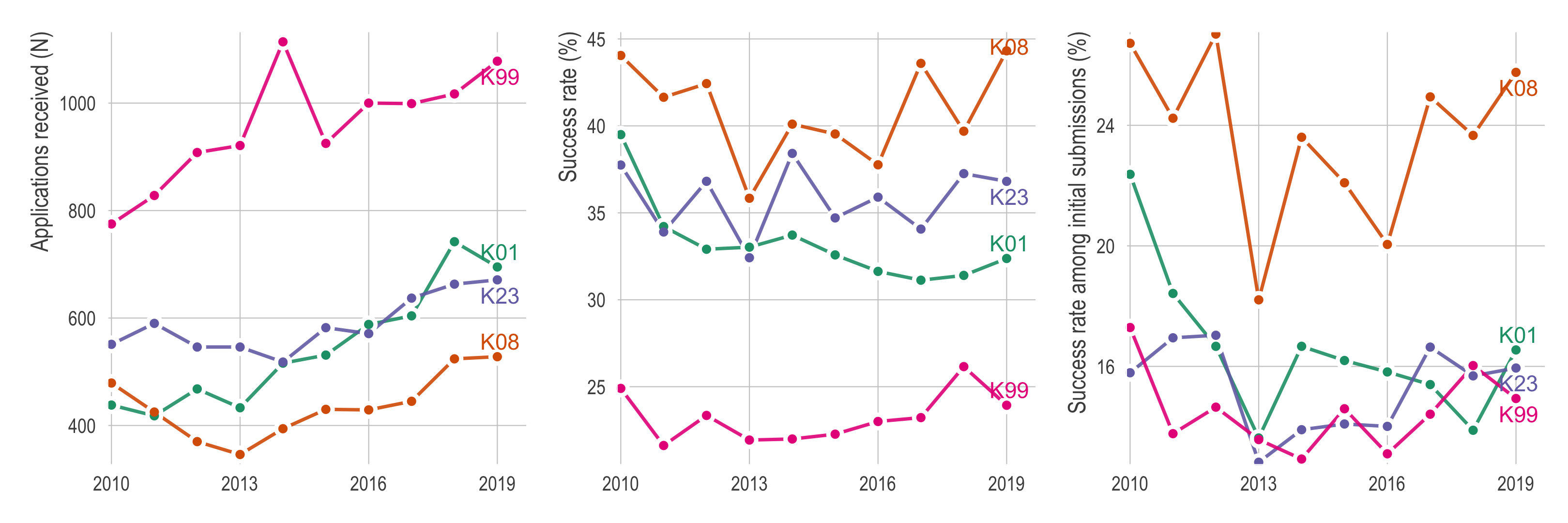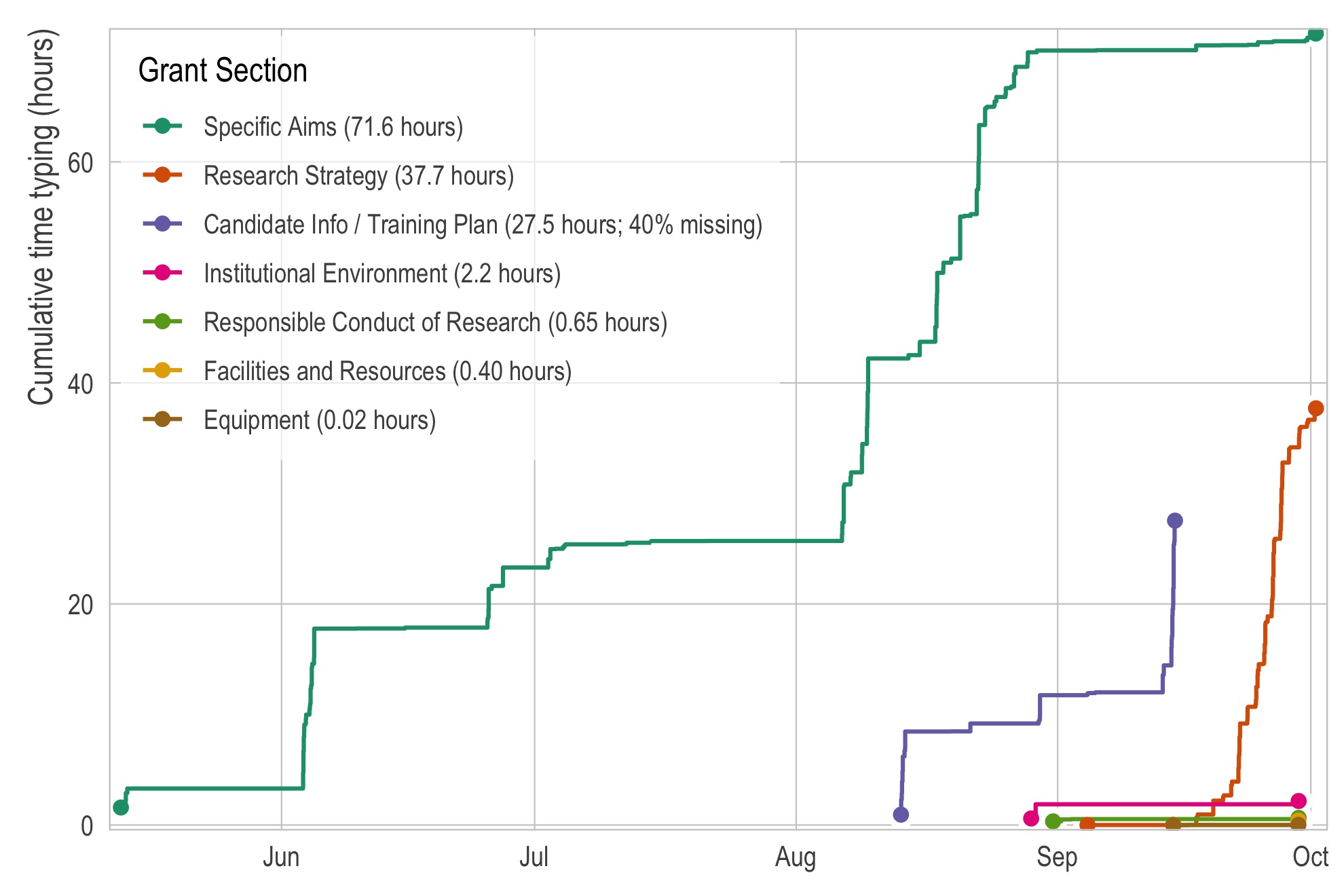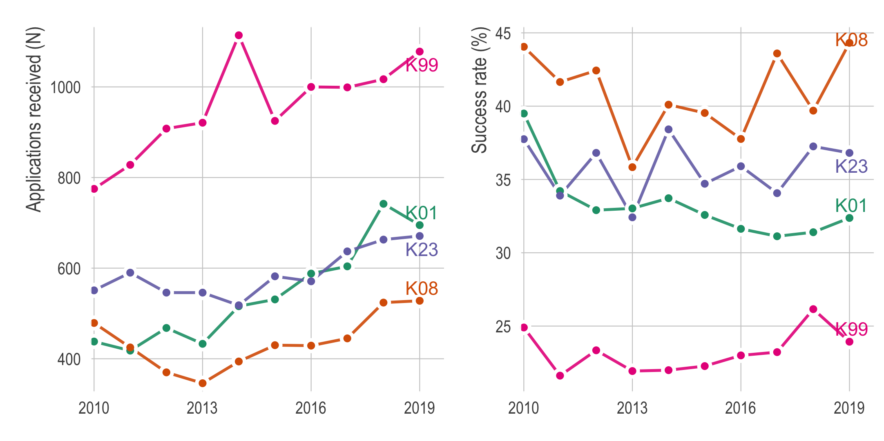Here, I will try to pay it forward by sharing some thoughts and advice. There are plenty of good blog posts about applying for K99’s, so I’ll try to avoid repeating those. Instead, I’m going to focus on things I didn’t know before and/or didn’t read elsewhere. It will be based on (1) insight from others who applied, (2) advice from mentors of successfully funded applicants, and (3) my interpretation from reading about 20 K-award summary statements and applications (both funded and unfunded).
If there’s enough interest in the topic, I might write about the writing process itself, but here I’m going to focus on things to do before you apply. The tl;dr is (1) consider non-K99 options, (2) apply early in your postdoc, (3) give yourself more time than you think you’ll need, (4) be strategic about your target institution, and (5) avoid easy critiques.

First, a disclaimer: Survival bias is real — you should get advice from lots of different people (with both funded and unfunded applications). My impact score was “on the bubble” and I was very lucky. [Since several people have asked, I received an impact score of 22. Remember, this does not really mean anything year to year or institute to institute — talk with your PO as soon as you receive your summary statement.] The dice went my way this time, but a different day, a different cycle, or a different reviewer and it could have easily gone the other way. Treat all of this with an appropriate level of skepticism. Very smart people will likely disagree with some of this advice. I try to give some reasoning below so you can evaluate if it is appropriate for you.
1. Consider other options
Don’t get me wrong — the K99/R00 is a great mechanism. The K99 is the only training grant open to non-US citizens. For better or worse, K99’s are considered more “prestigious” than other K-types, which may be helpful in a competitive job market. Early data suggests more than 90% of K99 recipients transition to a faculty position. Anecdotally, K99/R00’s make candidates more appealing as new faculty hires while also providing protection and leverage during job negotiations. In general, K99/R00’s offer more money over a five-year period. Whether it’s the Matthew effect or selection bias, K99 recipients tend to convert to R01’s (or equivalents) rapidly with a larger proportion receiving an R01 within 5 years than recipients of other major K-types (K01, K08, K23) — despite similar publication records.
That said, if you can apply for other mechanisms, you should consider it. Among the four major K-types, the K99 has the highest number of submissions (Figure 1a) and the lowest overall success rate (Figure 1b). Since the beginning, NIH program directors were encouraging researchers to apply for other (non-K99) training grants.
A common argument against applying for other K-types is that the K99 receives more submissions but the general “competitiveness” of the pool is lower, and thus the success rate is artificially suppressed. If this is true, I haven’t seen evidence of it. My reasoning is that as the number of qualified applicants exceeds the number of available awards, randomness plays an increasingly important role. (See Appendix 1 of Robert Frank’s Success and Luck for a simulation of this.)
Those with clinical degrees should consider the K08 and K23 mechanisms, which have higher success rates among fewer applicants. Those with a tenure-track position or with the promise of a tenure-track position, should consider the K01.

Figure 1. (a) Number of applications received, by K-type, across all NIH institutes and centers. (b) Success rates, by K-type, across all NIH institutes and centers. (C) Success rates among initial submissions, by K-type, across all NIH institutes and centers. All plots are limited to the four major K-types, K01, K08, K23, and K99.
Note that at most institutes, K01’s are technically available to early career investigators AND postdocs so it may be tempting to apply for a K01 instead of a K99. However, reviewers may not consider a K01 applicant competitive if the applicant does not have either (a) a tenure-track position already or (b) has a “strong letter of commitment” from their institution that includes assurances of being promoted to such a position.
- Of the four K01’s that I read, reviewers explicitly identified whether or not the applicant had (a) or (b) every time. (Notably, this weakness also appeared on a handful of K99 summary sheets, including my own. However, your program officer should step in — I was asked to respond to all criticisms in my summary sheet except this one.)
- Empirically, it seems a tenure-track position (or the promise of one) is a de facto requirement for a K01 at NIDA. For example, of the 12 NIDA K01 recipients in their first year of funding (as of May 2020), only one is a postdoctoral researcher (nine are assistant professors, one is a research assistant professor, and one is an instructor).
- Results for the 21 NIDA K01 recipients in their second year of funding are similar (16 assistant professors, one associate professor, and four research scientists of different levels).
Check before applying and ask somebody who knows the norms and expectations of your field and target institute. Some institutes are explicit about this expectation.
2. Apply early in your postdoc (rather than when you’re “ready”)
In considering when to apply, I was given two opposing strategies. The first was to become as competitive as possible before applying. This would imply spending my first 18 months as a postdoc getting as many first-author papers as possible, then applying for a K99/R00 at the end of my second year, with the hope that it gets funded at some point in my third year. The reasoning here is that you only have one resubmission, so you want to wait until you are an exceptional candidate. Importantly, this strategy also gives you time to think about a project that will excite you for five years. Even with funding, five years on a project you are not passionate about is a suboptimal outcome. Finally, as one mentor put it, this is “the last great opportunity before tenure to change focus if you want to.”
The second strategy was to apply as early as possible, anticipate getting a rejection, and resubmit an improved application based on the feedback from your summary statement. This would imply writing the application during my first year, submitting it late in the first year or early in the second year, and resubmitting it the next cycle. If it gets accepted, I would start it my third or fourth year. If it gets rejected, I would enter the job market or apply through a different mechanism. The reasoning here is three-fold. First, the value of reviewer feedback outweighs whatever you can reasonably accomplish in a year or two. Second, very few K-awards are accepted on the initial submission anyways (see Figure 1c). Third, a strong K99 with reviewer feedback can be easily converted into a different grant application. Given these reasons, it is better to apply early, take your time with the initial submission, and spend time addressing the critical weaknesses for the resubmission.
I went with the second strategy. I had a fairly clear idea of what I wanted to work on and I had a hard limit on how much time I wanted to spend as a postdoc. I spent the first few months of my postdoc trying to get as many papers (in the relevant research area) into the publication pipeline as possible. At initial submission, I was not a strong candidate — I had 1 first-author paper and 1 co-first author paper (and around two dozen middle-author papers). However, nearly all my work was in the relevant research area and 1 of the papers came during my postdoc. By the time post-submission materials were requested, I had an additional 2 first-author papers, 1 of which was with my proposed mentor in a respected journal, and a middle-author paper in the relevant area. Notably, all three reviewers cited my lack of first-author papers as problematic. (The additional papers post-submission ameliorated some of their concerns.)
In the end, the reviewers’ concerns about my productivity did not sink my application. But, even if I was required to resubmit, I would have been in a good position for a resubmission with several new papers and detailed critiques that I could focus on.
Ultimately, you should do what you are comfortable with, but like most things in academia, there is a lot of randomness in the process and being an excellent candidate does not guarantee an award. I’ve read the summary sheets of many exceptional applicants (including some with CNS papers) who did not get funding. Getting a summary sheet early will likely yield actionable information.
3. Give yourself plenty of time
Estimate how much time you should allocate — then add 20%. There are blogs with tips on how to quickly write a K99/R00 application in three weeks or less than two months. It is possible, and quite frankly super impressive, but I would not recommend it.
Part of my reasoning for applying early was that it would be easier for me to take my time and I assumed a resubmission was necessary, which would put me at the maximum amount of time I wanted to stay in a postdoc position. On December 11, 2018, about three months into my post doc, I was encouraged to consider applying for a K99/R00 and began looking into it. I began drafting a list of rough ideas for Specific Aims on January 4th, 2019. Over the next four months, I bounced ideas around with friends and mentors. By May of 2019, I had thrown out at least a dozen ideas.
The first draft of anything even remotely resembling a Specific Aims page was not done until mid-June. After at least a half-dozen more restarts, the first version of what would eventually become my Specific Aims was not finished until mid-August. The last edit on my Specific Aims was made on October 1st, 2019. During this time, life happened and between unexpected medical issues and some funding instability, there was pretty much no way I could have submitted any earlier.
I should note that writing the rest of the grant application is a lot easier once your Specific Aims is in reasonable shape. But it still takes a lot of protected time. I set an auto-reply and stopped checking my email, declined all meetings, and stopping physically showing up to work for six weeks to focus entirely on my application. If you don’t have that sort of flexibility, adjust your timeline accordingly.

Figure 2. Amount of active time spent in Google Docs by K99/R00 application section. Note approximately 40% of data are missing for the Candidate Info / Training Plan (purple) section.
I spent somewhere around 150 hours just typing. In Figure 2, I tracked the amount of time I spent actively typing in Google Docs using Draftback. (For unknown reasons, I could only render 19,000 of my 33,000 revisions for my Candidate / Training Plan). This doesn’t include reading or literature reviews or preliminary data analysis or taking notes or formatting or staring at my monitor. It doesn’t include discussions with friends, collaborators, or mentors. This is just active time typing.
Note: There are at least three important caveats. (1) I am an exceptionally slow writer. (2) This was my first grant application. (3) I have a less well-defined research arc than many of my peers. It will almost certainly take you less time, but you should still give yourself a lot of breathing room.
4. Pick the right institute
When selecting a target institute, there are at least three things to consider: (1) research fit / framing, (2) success rates, and (3) a history of funding your primary mentor. The first two are largely fixed, but if your research topic crosses multiple institutes — for example, racial/ethnic disparities (NIMHD) in rates of substance use disorder (NIDA) in an aging population (NIA) — it is worth your time to pick the best one early on and target it appropriately.
Think about how to frame your research early. It is critical you understand your target institute’s priorities and frame the application accordingly. You can do that by:
- Carefully read the Strategic Plan of your target institution. This includes their mission statement and overarching goals as well as priority areas and cross-cutting and trans-NIH priorities. Your research is important and likely hit multiple priority areas — make it easy for reviewers to see this.
- Before and while writing your application, read your institute’s Notice of Special Interests. This gives you a sense of what the institute is currently interested. It also gives you concrete examples to cite. For example, it may help show how your application “closely aligns with the NIDA’s stated interest in sleep and substance use disorders (NOT-DA-20-021)” or other special interest.
- Use the NIH RePORTER and the NIH Matchmaker to identify similar projects. Make sure to look out for projects that may be too closely aligned with what you are proposing — redundant projects are less likely to get funded. Conversely, a research idea that targets a special interest area without many active projects may be more likely to get funded.
It goes without saying that you should not try to force a bad fit.
There is a lot of variation in success rates. If it seems like you can be competitive in more than one institute, consider the historical K99 success rates. Figure 3 shows the success rate (y-axis) over time (x-axis) by NIH institute or center (circles) with NIDA highlighted in red. The size of each circle is the number of applications that institute received. The solid blue line is the average success rate across all institutes (using loess regression weighted by number of applications). In 2019, NCI received the highest number of applications at 182 and NIMHD received the fewest at 6. NCI and NIMHD also had the lowest success rates at 12% (22/182) and 0% (0/6). Conversely, NHGRI had the highest success rate and funded over half of their applications (N=8/14; 57%). Notably, the average success rate has remained fairly stable from 2010 to 2019 at about 25%.

Figure 3. Success rates over time, by institute/center, with NIDA highlighted in red. The size of the circle is the number of applications. The blue line is the weighted-loess fit.
If possible, your primary mentor should have a history of funding with your target institute. In at least a half dozen summary statements, reviewers were quick to identify applicants whose primary mentors either did not have funding from the target institute or did not have an R01 (or equivalent) from an adjacent institute. The goal of the K99 is to prepare you to submit an R01 at the same institute. From the perspective of a reviewer, it is “lower risk” to fund an applicant with a mentor who has successfully accomplished that. Avoiding easy-to-critique issues like this will strengthen your application.
Conclusion
There is plenty more to write on the topic, but this blog post is much longer than I had planned. Instead, I’ll list a few quick summaries of things I may expand into a full post in the future (given interest and time).
- Present a cohesive, focused narrative. It is not enough that each section of your grant is excellent — they need to fit together. The difference between perfect or near-perfect applications and “on the bubble” applications almost always came down to a cohesive narrative. Candidates in both score ranges were excellent (e.g., scoring 1 on all reviewers) with great mentoring teams, clear specific aims, excellent training plans, and rigorous research strategies. However, the applicants with perfect scores were able to make it clear how each component was naturally and logically connected to every other component. These applications were written so that reading any one section gave you a general idea about every other section. They were masterful (mine was not).
- This Twitter thread about “grantsmanship” by M. S. AtKisson is great.
- Empathize with a stressed reviewer. Reviewers are people. Imagine an overworked researcher trying to review a stack of grant applications in between Zoom meetings and homeschooling their young child during a pandemic while writing their own grants and papers and living their personal lives — this is who you are writing for. They’ll do their best but it is not reasonable to expect that they will be able to carefully read and review every sentence of your grant. Make it easy on them visually by using plots, typefaces, and whitespace. Make it easy on them cognitively by sticking with a cohesive, simple, repetitive message.
- @AZFaust hits the nail on the head with “there is value in not surprising your reader.”
- Stay organized. For me, applying for an NIH grant was a major undertaking and the first time I was responsible for an end product that required the input or approval of dozens of people — many of whom I never met. Logistically and administratively, it was substantially more effort than my dissertation. Stay organized to keep it manageable. Create a checklist with every item (including items other people need to do). Read the instructions carefully. Read the scoring criteria carefully. Do whatever works best for you — working alone or with a group, at home or at the office, etc. — but do it in a way that will allow for rapid, continuous feedback from your (very busy) mentors and friends.
- If you’re interested, I used a Google Drive with an encrypted link that allowed anybody to edit without logging in. This helped minimize the friction necessary to get feedback. For example, I could create an in-document (hyperlinked) bookmark at a specific paragraph or sentence, and ask a mentor or friend to look at it in a single click. I’ve created a template of that Google Drive folder here. I could also send the link to friends or strangers and ask them to proofread specific sections. This may not work in all situations, but I cannot imagine trying to write a grant with sequential editing or waiting to receive edits.
- Focus on the Specific Aims. Use other K99 specific aims as a reference. The K99 specific aims are different than R’s or other K’s in that they summarize training goals, candidate background, and a set of two-staged research aims (the K-phase and the R-phase). This is deceivingly difficult — especially if you don’t have a few references to look at. Spend most of your time here and do not proceed until it is in very good shape.
- Play to your strengths. The two approaches to the training section that I have seen are (a) learn something completely new (e.g., a physician learning qualitative methods) or (b) build on your existing skill set (e.g., an epidemiologist learning a more advanced statistical method). For K99’s, most reviewers seemed to prefer candidates who proposed building on existing skills (but not always). (K01’s seemed divided between the two strategies.)
- Think about your mentoring team early.
- Your primary mentor should be a senior faculty — seniority > rockstar status. Reviewers were quick to point out when primary mentors were junior faculty. One summary statement included concerns about a primary mentor who was “only” an assistant professor — despite high productivity, multiple R01’s, a DP2, and a PECASE. Primary mentors with funding specifically for mentoring (K05 and K26) were universally identified as strengths by reviewers.
- Co-mentors (if applicable) should have well-defined, non-overlapping roles in your training plan. In general, they should clearly address an aspect of your application that your primary mentor cannot address (either substantively or methodologically).
- If they are not your official postdoc mentor, knowing who will be on your mentorship team early allows you to establish a relationship with them and potentially co-author papers. Saying your mentor will make time for you is less convincing than saying you and your mentor(s) have been meeting regularly for the last six months and hav a great relationship.
- Differentiate yourself from your primary mentor. A project that overlaps too much with the primary mentor’s research suggests a candidate does not have a clear “pathway to independence.” This is an absolute dealbreaker. Make sure to differentiate yourself from your primary mentor explicitly in the text. In addition, you should (a) limit the number of training goals that depend on their mentoring and (b) diversify your co-mentors in terms of research area and methodological expertise.
Remember to stay hydrated. Take breaks. Get as much rest as you can. Every now and then take a step back and remember why you’re doing this and who it will ultimately be for. Go easy on yourself. Good luck.
Appendix
Data, code, and plots
K99 success rates are available on the NIH website. To get the number of initial submissions, I used the NIH Exporter site and for each year, institute, and mechanism, I tallied the number of submissions that were not A1 submissions. Code and data to reproduce the plots are available on my Github. If you use RStudio, you can play with an interactive version of the plots by running shiny::runGitHub("mkiang/k_success_rates").
Writing and submission timeline
Below, I provide a detailed timeline with both actual dates as well as days relative to the submission deadline. I’ll leave it here in case it is helpful for others.
- 9/10/2018 (-397 days): First day as a post-doc.
- 12/11/2018 (-305 days): Convinced by MMG to apply for a K99/R00.
- 6/15/2019 (-119 days): First shareable version of a Specific Aims page is finished.
- 6/19/2019 (-115 days): Phone call with my program official (PO) to discuss my Specific Aims page and confirm eligibility.
- 10/1/2019 (-11 days): Final version of the application is sent to Stanford Research Management Group (RMG) for review and submission.
- 10/11/2019 (-1 days): Stanford RMG sends the application to the NIH.
- 10/12/2019 (0 days): K99/R00 application is due.
- 2/7/2020 (+118 days): Post-submission material is requested by my PO.
- 2/13/2020 (+124 days): Post-submission material (additional publications) is sent to my PO.
- 3/19/2020 (+159 days): Study section meets to discuss all K99/R00s.
- 3/19/2020 (+159 days): Impact score is updated online.
- 4/7/2020 (+178 days): Summary statement is available online.
- 4/7/2020 (+178 days): Receive a request from my PO to respond to critiques raised in the summary statement.
- 4/9/2020 (+180 days): Phone call with my PO to discuss the parameters of my response to the summary statement.
- 4/14/2020 (+185 days): Response to the summary statement is sent to my PO.
- 5/12/2020 (+213 days): NIDA council meeting.
- 5/14/2020 (+215 days): PO informs me just-in-time (JIT) information will be requested by NIDA Grants Management Branch.
- 5/27/2020 (+228 days): Submitted JIT information through Stanford RMG.
- 5/28/2020 (+229 days): JIT information is due.
- 6/12/2020 (+244 days): Status (on eRA Commons) updated to “Awarded.” NOA uploaded a couple hours later.
- 7/1/2020 (+263 days): Project start date.
